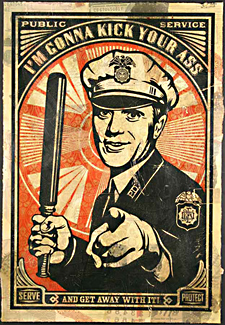Police-Thugs with Gunsby Wendy McElroy, Future of Freedom FoundationAug. 23, 2011 |
Popular 
House Passes 'Antisemitism Awareness Act' to Silence Criticism of Israel as Hate Speech

WATCH: Sheryl Sandberg's Vile 'Hamas Mass Rape' Documentary Debunked by Electronic Intifada

Zionist Mob Attacks Pro-Palestine Protesters at UCLA While Screaming 'Second Nakba'

Report: Over 1,700 People Have Been Arrested on Campuses Nationwide in Past Two Weeks

'We Own This Country': Mark Levin Says Pro-Palestine Protesters Should be 'Rounded Up and Deported'
  When police brutality cannot be covered up or dismissed by blaming the victim, the next official line is often the “bad apple” defense. The popular phrase “one bad apple can spoil the bunch” generally means that one person’s behavior can negatively reflect upon or influence others. When used defensively, however, the phrase “bad apple” is meant to suggest that it is unfair to focus on a single miscreant and imply that his behavior indicates anything true about a larger group to which he belongs. When police brutality cannot be covered up or dismissed by blaming the victim, the next official line is often the “bad apple” defense. The popular phrase “one bad apple can spoil the bunch” generally means that one person’s behavior can negatively reflect upon or influence others. When used defensively, however, the phrase “bad apple” is meant to suggest that it is unfair to focus on a single miscreant and imply that his behavior indicates anything true about a larger group to which he belongs.On July 5, when an unarmed, homeless man named named Kelly Thomas was beaten and tasered by a group of Fullerton, California, police officers, the brutality could not be covered up because of the presence of witnesses and a recording that went “YouTube.” The police department’s standard attempt to blame the victim was unsuccessful. The officers referred to car break-ins for which Thomas may have been responsible but for which he was not arrested; then they added “resisting” to his crimes. Unfortunately for the police, witnesses and the recording testified to Thomas’s lying submissively on the ground, crying out poignantly for his father, while the police officers beat and tasered the life out of him. A total of six officers were involved in subduing him. On July 7, the Orange County District Attorney opened an investigation into the beating of Thomas, who died of his injuries on July 10. When the FBI joined the investigation, the top administrator of the American Civil Liberties Union (ACLU) of Southern California, Hector Villagra, applauded, stating that the “district attorney has an abysmal track record when it comes to investigating and prosecuting officer-involved deaths.” The ACLU may have been reassured by the FBI presence but the public should be shaken to its core. What does it take to convict police officers of misconduct? Clearly, the dead body of an unarmed man who was “subdued” by six officers is not enough. Witnesses and a recording of the incident are not enough. An investigation by the DA is the opposite of “not enough” because it returns to the default position of cover-up. Will the presence of FBI agents be enough, or will an act of Congress be necessary? Something far worse and more extensive than a “bad apple” — or six of them — happened to Thomas Kelly. If he had encountered a rogue cop, then that man could be fired and the problem solved. This is what police apologists wish the public to believe: that police departments across America have problems, like every other organization, but they are fundamentally sound. Kelly Thomas proves differently. He encountered a group that acted in concert in causing or contributing to his death. His family confronted a legal system committed to justifying and excusing any death caused by the police. Typically, such accused officers are given “paid leave” during an investigation and then returned to the streets. Arguably, the largest barrier to revolutionary change in law enforcement is the utter and deliberate absence of transparency, without which there is no accountability. When there is occasional and accidental transparency, as with Kelly Thomas, the public outrage often leads to show trials, to suspension of officers, or even to a change in police chiefs. If transparency were a pervasive and mandatory aspect of law enforcement, if police officers were held criminally accountable for what transparency revealed, then those changes alone might well reduce police brutality to being a practice found only among “rogue cops.” A recently published investigative report provides an indication of how unlikely transparency is to occur in the near future. The report focuses on the disastrous effect of a 2006 court ruling on police transparency. In August 2006, the California Supreme Court ruled in Copley Press v. Superior Court of San Diego that records of the administrative appeal on sustained misconduct charges may not be disclosed to the public. Previously, public access to complaints were kept confidential by internal affairs but made accessible during administrative appeals. Also, investigative packets from the Citizens’ Police Review Board (CPRB) — established in 1980 in response to public demand for independent investigation of complaints — were made generally available; now complaints are no longer included. In effect, Copley closed those windows into police conduct. The public no longer has any right to know the names of disciplined officers or the nature of their offenses. Although names are sometimes still released, especially in shooting cases, the release is at the discretion of specific police departments in California. Tom Newton, executive director of the California Newspaper Publishers Association, said, “They’ve [police unions] been relentless over the past 25 years to create a tool for law-enforcement agencies to work without public scrutiny. With Copley, they hit the jackpot.” In an article entitled “Deadly Secrets: How California Law Has Shielded Oakland Police Violence,” the news and activist site Colorlines offers Sgt. Patrick Gonzales of the Oakland Police Department (OPD) as an example of the damage wrought by Copley. During his 13-year career, Sergeant Gonzales has shot four people; three died. One of the dead was a 20-year-old man named Gary King Jr., whom Gonzales shot twice in the back. Several lawsuits against Gonzales allege a wide range of offenses from wrongful death to excessive force, from illegal searches to racial profiling; the city has paid out approximately $3.6 million to settle the lawsuits. Colorlines states, “Yet, Gonzales has been consistently promoted and deployed into sensitive situations throughout his career, and without public outcry. That’s because few know about either his record or his promotions. His extensive personnel file is today off-limits to the public.... The arc of Gonzales’ career tells the story of a department’s broken accountability system, now pushed behind a wall of secrecy.” Pre-2006 complaints against Gonzales that are public knowledge include a 2001 complaint that reads, in part, “Mr. Piazza inquired as to why he and Mr. Moore were detained and was told to ‘shut up’ by Officer Gonzales.” After finding they had no warrants, the police released Moore and began to search the 18-year-old Piazza, perhaps because he had questioned his detention. Although they were in a public street that was “heavy with vehicular traffic,” “Officer Gonzales placed Mr. Piazza next to the open door of the police vehicle and proceeded to pull his pants down to his knees. Officer Gonzales then pulled Mr. Piazza’s underwear halfway down his buttocks.” Gonzales searched the anal cavity for drugs. “Officer Gonzales next lifted and pulled Mr. Piazza’s head back, and then squeezed his throat with one hand, and pressed open the side of his jaw with the other” in order to search for drugs in his mouth. When Piazza complained of a rights violation, Gonzales slapped him across the face with an “open right hand.” When asked why he slapped Piazza, Gonzales answered, “Because I can,” and threatened the watching Moore with a baton when Moore objected. Piazza was later treated at a hospital for a dislocated jaw. The foregoing is an example of information that is no longer available to the public. “Deadly Secrets” states, “Without CPRB records, lawsuits are the only remaining way for records of shooters to become public. As a result, accountability activists say, it is now extremely difficult to keep tabs on officer conduct. Rachel Jackson, an organizer of the Bay Area protests of Oscar Grant’s killing [an unarmed man killed when he was shot in the back], says the indictment on murder charges of ex-BART Officer Johannes Mehserle, following widespread public outcry, is proof of the point, ‘If there’s street heat, they’ll do something.’” The culture of silence that surrounds and protects police misconduct also encourages it. The silence does not result from “bad apples” or the occasional rogue cop but from the systematic and systemic protection of brutality, from the police’s protecting their own authority. At this point, it is difficult to believe the police would ever willingly relinquish the walls that shield them from “street heat.” Public outrage is the one force that could destroy their power by exposing officers like Gonzales as thugs with guns and a pension; but exposing such cases requires transparency. Because of Copley, the families of those killed in the streets of California by police officers may need to bring a lawsuit in order to learn the name of their child’s killer. Or they may find a police chief who still has a heart. What are the odds? __ Wendy McElroy is the author of The Reasonable Woman: A Guide to Intellectual Survival (Prometheus Books, 1998). She actively manages two websites: http://www.ifeminists.com and http://www.wendymcelroy.com. For additional articles on current events by Ms. McElroy, please visit the Commentary section of our website. |



